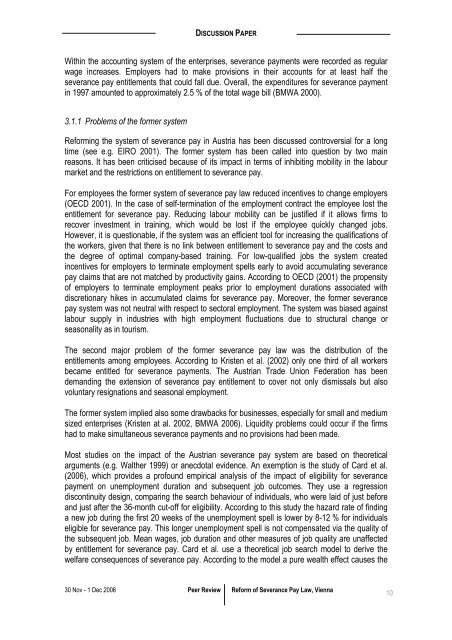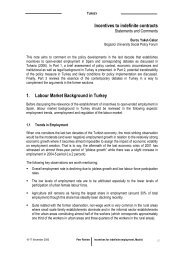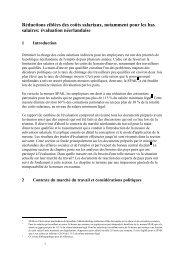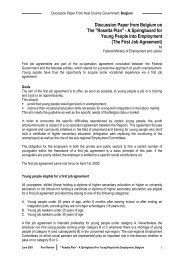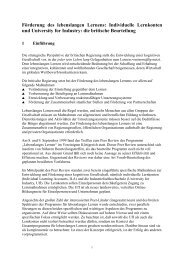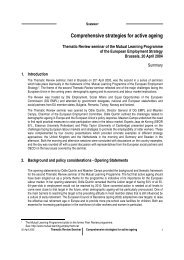Reform of Severance Pay Law in Austria - mutual learning programme
Reform of Severance Pay Law in Austria - mutual learning programme
Reform of Severance Pay Law in Austria - mutual learning programme
You also want an ePaper? Increase the reach of your titles
YUMPU automatically turns print PDFs into web optimized ePapers that Google loves.
DISCUSSION PAPER<br />
With<strong>in</strong> the account<strong>in</strong>g system <strong>of</strong> the enterprises, severance payments were recorded as regular<br />
wage <strong>in</strong>creases. Employers had to make provisions <strong>in</strong> their accounts for at least half the<br />
severance pay entitlements that could fall due. Overall, the expenditures for severance payment<br />
<strong>in</strong> 1997 amounted to approximately 2.5 % <strong>of</strong> the total wage bill (BMWA 2000).<br />
3.1.1 Problems <strong>of</strong> the former system<br />
<strong>Reform</strong><strong>in</strong>g the system <strong>of</strong> severance pay <strong>in</strong> <strong>Austria</strong> has been discussed controversial for a long<br />
time (see e.g. EIRO 2001). The former system has been called <strong>in</strong>to question by two ma<strong>in</strong><br />
reasons. It has been criticised because <strong>of</strong> its impact <strong>in</strong> terms <strong>of</strong> <strong>in</strong>hibit<strong>in</strong>g mobility <strong>in</strong> the labour<br />
market and the restrictions on entitlement to severance pay.<br />
For employees the former system <strong>of</strong> severance pay law reduced <strong>in</strong>centives to change employers<br />
(OECD 2001). In the case <strong>of</strong> self-term<strong>in</strong>ation <strong>of</strong> the employment contract the employee lost the<br />
entitlement for severance pay. Reduc<strong>in</strong>g labour mobility can be justified if it allows firms to<br />
recover <strong>in</strong>vestment <strong>in</strong> tra<strong>in</strong><strong>in</strong>g, which would be lost if the employee quickly changed jobs.<br />
However, it is questionable, if the system was an efficient tool for <strong>in</strong>creas<strong>in</strong>g the qualifications <strong>of</strong><br />
the workers, given that there is no l<strong>in</strong>k between entitlement to severance pay and the costs and<br />
the degree <strong>of</strong> optimal company-based tra<strong>in</strong><strong>in</strong>g. For low-qualified jobs the system created<br />
<strong>in</strong>centives for employers to term<strong>in</strong>ate employment spells early to avoid accumulat<strong>in</strong>g severance<br />
pay claims that are not matched by productivity ga<strong>in</strong>s. Accord<strong>in</strong>g to OECD (2001) the propensity<br />
<strong>of</strong> employers to term<strong>in</strong>ate employment peaks prior to employment durations associated with<br />
discretionary hikes <strong>in</strong> accumulated claims for severance pay. Moreover, the former severance<br />
pay system was not neutral with respect to sectoral employment. The system was biased aga<strong>in</strong>st<br />
labour supply <strong>in</strong> <strong>in</strong>dustries with high employment fluctuations due to structural change or<br />
seasonality as <strong>in</strong> tourism.<br />
The second major problem <strong>of</strong> the former severance pay law was the distribution <strong>of</strong> the<br />
entitlements among employees. Accord<strong>in</strong>g to Kristen et al. (2002) only one third <strong>of</strong> all workers<br />
became entitled for severance payments. The <strong>Austria</strong>n Trade Union Federation has been<br />
demand<strong>in</strong>g the extension <strong>of</strong> severance pay entitlement to cover not only dismissals but also<br />
voluntary resignations and seasonal employment.<br />
The former system implied also some drawbacks for bus<strong>in</strong>esses, especially for small and medium<br />
sized enterprises (Kristen at al. 2002, BMWA 2006). Liquidity problems could occur if the firms<br />
had to make simultaneous severance payments and no provisions had been made.<br />
Most studies on the impact <strong>of</strong> the <strong>Austria</strong>n severance pay system are based on theoretical<br />
arguments (e.g. Walther 1999) or anecdotal evidence. An exemption is the study <strong>of</strong> Card et al.<br />
(2006), which provides a pr<strong>of</strong>ound empirical analysis <strong>of</strong> the impact <strong>of</strong> eligibility for severance<br />
payment on unemployment duration and subsequent job outcomes. They use a regression<br />
discont<strong>in</strong>uity design, compar<strong>in</strong>g the search behaviour <strong>of</strong> <strong>in</strong>dividuals, who were laid <strong>of</strong> just before<br />
and just after the 36-month cut-<strong>of</strong>f for eligibility. Accord<strong>in</strong>g to this study the hazard rate <strong>of</strong> f<strong>in</strong>d<strong>in</strong>g<br />
a new job dur<strong>in</strong>g the first 20 weeks <strong>of</strong> the unemployment spell is lower by 8-12 % for <strong>in</strong>dividuals<br />
eligible for severance pay. This longer unemployment spell is not compensated via the quality <strong>of</strong><br />
the subsequent job. Mean wages, job duration and other measures <strong>of</strong> job quality are unaffected<br />
by entitlement for severance pay. Card et al. use a theoretical job search model to derive the<br />
welfare consequences <strong>of</strong> severance pay. Accord<strong>in</strong>g to the model a pure wealth effect causes the<br />
30 Nov - 1 Dec 2006 Peer Review <strong>Reform</strong> <strong>of</strong> <strong>Severance</strong> <strong>Pay</strong> <strong>Law</strong>, Vienna<br />
10


